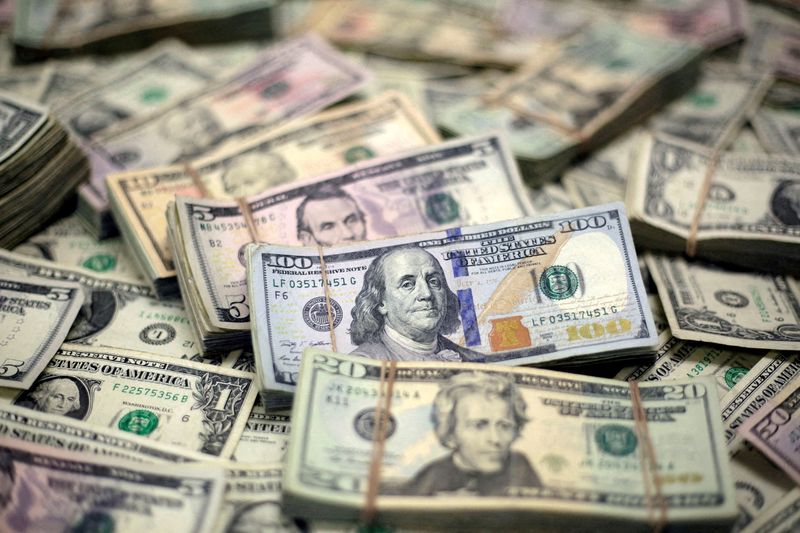By Mike Dolan
LONDON (Reuters) – The dollar just had its best week in two years, showing once again how dangerous it can be to bet against the U.S. currency if the rest of the world just won’t let it drop.
The DXY index, which tracks the dollar against the most widely traded global currencies, surged more than 2% last week – a stunning whiplash, not least for the many speculators who were short on the greenback and waiting for it to swoon.
While the rally was supercharged partly by the blowout U.S. employment report – and related rethink on the Federal Reserve’s interest rate trajectory – the dollar’s rebound was well underway before Friday. The payrolls figures merely put the icing on the cake.
The main catalyst for the renewed dollar strength was the clear signals coming from central banks in Europe and Japan that any efforts by the Fed to up the ante on rate cuts would be matched in kind.
The rest of the world’s major central bankers certainly took note of the Fed’s outsize 50 basis point opening salvo last month in what it flagged as a 250 basis point easing cycle.
The move was followed by a series of pointed comments from chiefs and governors of the European Central Bank, Bank of England and Swiss National Bank. They all suggested their own decks were being cleared for accelerated easing as well.
While the Bank of Japan had been moving in the opposite direction, both the BoJ and the country’s new prime minister threw cold water on plans to further ‘normalize’ policy with higher rates following the Fed’s large cut.
Add to that signs that the SNB is already intervening in currency markets to cap the rise of the Swiss franc, ongoing intervention from the Reserve Bank of India, and even a rebound in China’s foreign currency reserves, and it’s easy to see why the dollar’s long-forecast downward path has been frustrated.
‘STAGGERING’ ACCUMULATION OF US ASSETS
But the really big capital shifts buoying the dollar in less in the public than the private space and reflect the seemingly insatiable appetite of overseas investors for U.S. assets.
Societe Generale (OTC:SCGLY)’s currency strategist Kit Juckes this week puzzled over why the dollar is rising again so shortly after the Fed has started cutting rates. He noted that the two previous multi-year dollar rallies over the past 50 years were completely reversed after Fed easing commenced.
Juckes highlighted data showing that Japanese trust funds have already resumed buying U.S. Treasuries and overseas demand for dollar call options is rising. The quick return to already overcrowded U.S. markets is, in his words, “taking U.S. exceptionalism to new levels.”
So the dollar remains stubbornly over-valued: the real, broad trade-weighted index is still some 30% above levels seen 10 years ago. This is creating growing disquiet about the sheer scale of global exposure to U.S. assets, the peculiar twist that has on the dollar exchange rate and its effect on U.S. competitiveness and the reemergence of anxiety about ‘global imbalances’ that was prevalent 20 years ago.
SocGen strategist Juckes highlighted that foreign investors had increased their net holdings of U.S. assets by a “staggering” $40 trillion since 2020 – making it all the more remarkable that this thirst hasn’t yet been slaked.
“I’m certain that a weaker dollar would help reduce some of the imbalances in the global economy, but if investors have so little confidence in their domestic policies and asset markets that they are already returning to the U.S., how does it happen?” he said.
What’s more, there’s little or no sign that U.S. investors have the remotest interest in underperforming overseas markets.
U.S. mutual fund numbers have seen net outflows from global equities over the last month, a fairly consistent trend since the Fed began raising interest rates in March 2022.
So what could shake investors’ unerring faith in the resilience of the U.S. economy, and by extension, the greenback?
Geopolitical concerns are certainly as high as we’ve seen in many decades. But this, arguably, increases safe haven demand for dollars, encourages U.S. money to hunker down at home and enhances the attraction of unrivalled U.S. scale and liquidity.
Could the U.S. election or threats to U.S. democracy and institutions rankle investors?
Certainly a return of Donald Trump to the presidency following the Nov. 5 election may raise concerns, not least given Trump’s well-aired support for both a weak dollar and political control of the Fed.
But it’s telling given that that even with the White House race on a knife edge, the world still appears determined to keep the dollar aloft.
The opinions expressed here are those of the author, a columnist for Reuters

